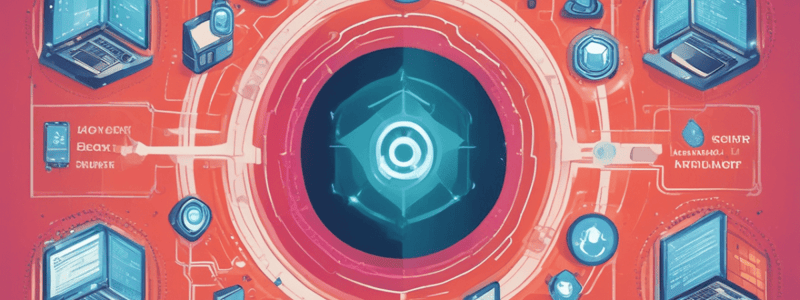Podcast
Questions and Answers
Who is responsible for coordinating and managing Privci's information security program?
Who is responsible for coordinating and managing Privci's information security program?
- Information Owners
- Information Security Manager (correct)
- Information Custodians
- Executive Management
What is the responsibility of Information Owners according to the Information Security Policy?
What is the responsibility of Information Owners according to the Information Security Policy?
- Granting and revoking access to information
- Implementing and managing security controls
- Classifying and labeling information assets (correct)
- Coordinating and managing Privci's information security program
What is the primary responsibility of Information Custodians according to the Information Security Policy?
What is the primary responsibility of Information Custodians according to the Information Security Policy?
- Classifying and labeling information assets
- Implementing and managing security controls
- Coordinating and managing Privci's information security program
- Granting and revoking access to information (correct)
What is the role of users according to the Information Security Policy?
What is the role of users according to the Information Security Policy?
What is the purpose of periodic risk assessments mentioned in the Information Security Policy?
What is the purpose of periodic risk assessments mentioned in the Information Security Policy?
What is the purpose of a business continuity and disaster recovery plan according to the Information Security Policy?
What is the purpose of a business continuity and disaster recovery plan according to the Information Security Policy?
What type of authentication mechanisms are enforced according to the Information Security Policy?
What type of authentication mechanisms are enforced according to the Information Security Policy?
What is required for remote access to information assets according to the Information Security Policy?
What is required for remote access to information assets according to the Information Security Policy?
Study Notes
- Privci Ltd's Information Security Policy outlines guidelines and requirements for safeguarding privileged and sensitive information and ensuring the availability, integrity, and confidentiality of information assets.
- The policy applies to all individuals with access to information assets and covers areas such as roles and responsibilities, risk assessment, security awareness and training, incident response, access control, physical security, network security, compliance, and policy review.
- The Information Security Policy is owned by the Privci Information Security Manager and is subject to periodic review and updates.
- Executive management is responsible for supporting and enforcing the policy, providing adequate resources for information security, and ensuring compliance with applicable regulations and standards.
- The Information Security Manager is responsible for coordinating and managing Privci's information security program and maintaining the effectiveness of security controls.
- Information Owners are responsible for classifying and labeling information assets, ensuring adequate protection measures are in place, and making informed decisions regarding access controls, storage, and transmission of information.
- Information Custodians are responsible for implementing and managing security controls and ensuring access to information is granted and revoked in accordance with access control policies.
- Users must understand and comply with information security policies and procedures, and all employees and contractors must report security incidents to the Information Security Manager immediately.
- Privci conducts periodic risk assessments to identify vulnerabilities and prioritize risk mitigation efforts.
- Security awareness and training programs are provided to educate employees, contractors, and other individuals regarding their information security obligations and responsibilities.
- An incident response plan is in place to manage and respond to security incidents and all employees and contractors must report incidents to the Information Security Manager.
- Business continuity and disaster recovery plans are developed and maintained to ensure the timely restoration of information assets and business operations.
- User access management processes are implemented to grant and revoke access rights to information systems and assets based on user roles and responsibilities.
- Strong authentication mechanisms and password management policies are enforced to ensure only authorized individuals can access information systems and assets.
- Remote access to information assets must be approved by management and implemented using secure communication channels and multi-factor authentication.
- Physical access controls are in place to restrict access to information assets, and equipment security measures are implemented to ensure the security of equipment used for processing, storage, or transmission of information assets.
- Network architecture and segmentation are implemented to isolate sensitive information assets and reduce the impact of potential security incidents.
- Network monitoring and logging systems are used to detect and investigate unauthorized access attempts, anomalies, and security events.
- Secure remote access mechanisms are implemented to protect information assets while being accessed remotely.
- An incident response plan is in place, and all employees and contractors must report any suspected or detected security incidents to the Information Security Manager immediately.
- Compliance with laws, regulations, and industry standards is a priority, and periodic security audits are conducted to assess the effectiveness of information security controls and ensure compliance with internal policies and external requirements.
- Measures are implemented to identify, assess, and manage the security risks associated with third-party providers handling Privci's information assets.
- The Information Security Policy is reviewed annually or as necessary to reflect changes in the risk landscape, legal and regulatory requirements, and industry best practices.
Studying That Suits You
Use AI to generate personalized quizzes and flashcards to suit your learning preferences.




